The First Helmet Radio: Paul Brown and Football’s Forgotten Dynasty
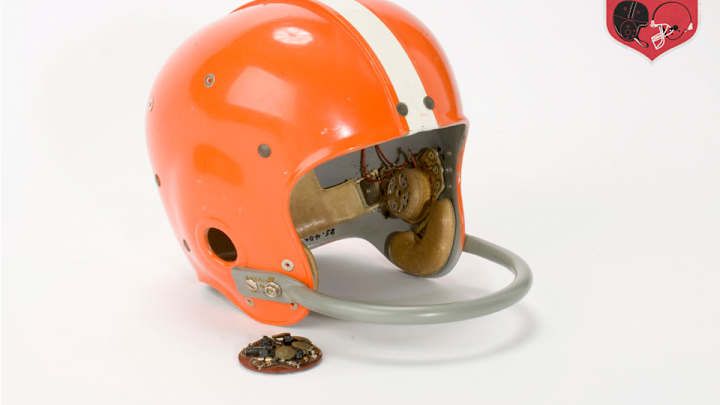
Editor’s note: This is the fifth in The MMQB’s 10-part series NFL 95: A History of Pro Football in 95 Objects, commemorating the 95th season of the NFL in 2014. Each Wednesday through the start of training camp in July, The MMQB will unveil one long-form story on an artifact of particular significance to the history of the NFL, accompanied by other objects that trace the rise of professional football in America, from the NFL’s founding in a Hupmobile dealership in Canton in 1920 to its place today at the forefront of American sports and popular culture.
BY MARK BECHTEL
Of all the things a Cleveland police officer expected to see on an otherwise normal 1956 day, a grown man roaming out of the woods wearing a helmet that was making strange noises couldn’t have ranked too high on the list. But there he was, George Sarles, ambling into the arms of one of Cleveland’s finest with an orange football helmet on his head, listening to the sounds being picked up by the four-watt receiver inside.
Who knows what the cop thought? It was the peak of the Cold War, the space race was just gaining momentum, and a fair amount of rocket work was being done at Lewis Research Center a few miles from the Cleveland airport. Sarles might have looked like a crashed Soviet recon pilot, but he wasn’t. He was an electronics gadget salesman, and he was testing out a new invention at the behest of Paul Brown: a radio communication system that would allow Brown, the head coach of the Cleveland Browns, to communicate with his quarterback during games. Sarles and his friend, a GE engineer named John Campbell, had come up with the idea and approached Brown, who received the idea warmly. It wasn’t Brown’s first time dabbling in revolutionary headgear. A year earlier he had patented the single-bar facemask, not long after jury-rigging a lucite mask to protect his injured quarterback, Otto Graham. Brown saw the helmet transistor as just one of the possible uses of radio technology: Eventually he hoped to stick observers high up in eagle-eye vantage points in stadiums and communicate with them over shortwave. (A vision that, of course, came to fruition years later with communications between assistant coaches up in a booth and the men on the sideline.)

The MMQB’s special 10-part series tracing pro football’s rise through the artifacts that shaped the game. Every Wednesday through the start of training camp.
Week 4: The Day the NFL Died in L.A.
Week 3: Bill Walsh’s Enduring Genius
Week 2: Artifical Turf: Change From the Ground Up
Week 1: Steve Sabol’s Office: Where Legend Lives On
Luckily, the policeman who discovered Sarles was a football fan, and he sent the salesman on his way. Satisfied that the helmet would give him an edge, Brown first used it in a preseason game against the Detroit Lions that year. Since Brown was technically broadcasting a radio signal, he had to obtain a call number—19A1661—from the FCC. The Lions became suspicious when they realized that Brown was no longer using offensive linemen to shuttle in plays. In the second half, a Lions assistant finally discovered the transmitter attached to a light post behind the Cleveland bench.
When word of the radio system got out, Brown faced backlash from around the league, but that didn’t stop him from using it. During the 1956 season opener against the Cardinals in Chicago, quarterback George Ratterman wore the helmet and had to contend with outside interference. “I’m getting cab calls from Michigan Avenue to State Avenue,” he complained to his teammates.
Two weeks later, as the controversy raged on, Brown announced his intention to use the device against the Giants at Yankee Stadium—and went so far as to warn New York that interfering with the signals would be a violation of FCC regulations that would subject them to a $10,000 fine. The Giants simply listened in and asked a former Browns player to decipher what was being said, then prepared accordingly. Of course, not everything he heard was football related. Among the chatter picked up were NYPD communications. The experiment finally ran its course when Ratterman called timeout, took off the helmet and reported to Brown: “Coach, some guy just got stabbed over on Fifth Avenue.” With New York sitting on Cleveland’s plays, Brown finally had Ratterman go back to a traditional helmet. A few days after the game, which the Giants won 21–9, commissioner Bert Bell outlawed radio-equipped headgear.
Three weeks later Ratterman would suffer a career-ending knee injury, an early victim of the SI cover jinx. He landed on his feet—barely. In 1961, while he was running for sheriff of Campbell County, Ky., a band of local criminals drugged him, put him in a hotel room with a stripper, and hired a photographer to document the whole thing. Ultimately the photographer confessed, Ratterman was elected, and, he boasted later, “In four years I got rid of the gambling and the prostitution—and I didn’t get killed.” The helmet also survived: It’s now part of the Hall of Fame’s Gridiron Glory traveling exhibit.
Ironically, Brown had already pioneered a way to deliver plays to the huddle: the messenger guard. (Brown was the rare coach who called his plays, which was a source of tension between himself and Graham.) But Brown was a man constantly in search of an edge, so when the opportunity to refine his communication system presented itself, he jumped. That was the way he operated. For a man whose life away from the football field was straight-laced to the point of being dull, Paul Brown loved being on the cutting edge. And the result of that perpetual desire for innovation was one of the most criminally underappreciated eras in the history of pro football, a decade in which the Browns were the sport’s model franchise. That’s the Cleveland Browns, the team that has in recent years so expertly combined abject on-field performances with comical front-office moves that its rich tradition has been all but overwhelmed by the odious olio of misery it serves its fans for dinner every autumn Sunday.
And in their heyday, the Browns didn’t just win. They revolutionized the game and made football fans reconsider everything they thought they knew about the game. It all began with an upstart league and a coach with an experimental streak.
* * *
The All-America Football Conference was founded in 1944 by Chicago newspaperman Arch Ward, who had also been responsible for the birth of baseball’s All-Star Game. The Cleveland franchise was owned by Mickey McBride, a local real estate and taxicab tycoon. After a deal to bring Notre Dame coach Frank Leahy to Cleveland fell through, McBride turned his attention to Paul Brown, who had led Ohio State to the 1942 national championship before taking a job as the coach at Great Lakes Naval Station during World War II. (Another Brown innovation: the taxi squad, a collection of non-roster reserve players ready at a moment’s notice; the moniker originated because Brown gave the players jobs driving cabs for McBride. The idea lives on in teams’ practice squads.)
Paul Brown (left) and owner Mickey McBride celebrated with players after the Browns won their second straight AAFC title in December 1947. (AP)

Brown filled his roster largely with players he knew from Ohio State and the Navy. His quarterback, Graham, had beaten the Buckeyes twice when Graham was at Northwestern. Lou Groza, a tackle and kicker, had played on the freshman team at OSU before being sent to Okinawa. End Dante Lavelli was a part of Brown’s title team before he was shipped off to join the 28th Infantry Division. Another end, Mac Speedie, caught Brown’s eye while playing for the Fort Warren base team.
Paul Brown integrated pro football without uttering a single word about integration," said Jim Brown. "He just went out, signed a bunch of great black athletes, and started kicking butt.
In his search for players, Brown would consider anyone. That led to another innovation, of sorts: the use of African-American players, an unwritten taboo in pro football since 1933. Brown signed Bill Willis, a middle guard from Ohio State, and Marion Motley, a fullback/linebacker from Great Lakes. Willis was a safe bet; the 24-year-old had been the MVP of the 1944 College All-Star Game. Motley was more of a stretch; he was 27 and working in a mill to support four children when Brown reached out. “I think they felt [Willis] needed a roommate,” said Motley, who would go on to win rushing titles in both the AAFC and the NFL. (Another Brown innovation: the draw play, which came about on a busted play when Graham, under extreme pressure, handed the ball to Motley, who slipped past the onrushing defenders for a big gain.)
Willis and Motley were on the field on Sept. 6, 1946, when the Browns beat the Miami Seahawks 44–0 in their first game. The AAFC pair broke pro football’s color barrier two weeks before Woody Strode and Kenny Washington of the Los Angeles Rams became the NFL’s first black players in 13 years. “Paul Brown integrated pro football without uttering a single word about integration,” Jim Brown told sportswriter Terry Pluto years later. “He just went out, signed a bunch of great black athletes, and started kicking butt. That’s how you do it. You don’t talk about it. Paul never said one word about race.”
But Brown wouldn’t sign just anybody. He instituted screening procedures that were stringent by CIA standards, let alone what the football world was accustomed to. He is widely credited with (or blamed for) using the 40-yard dash to gauge players. (Depending on whom you ask, he picked 40 yards either because it’s the farthest distance a player has to sprint on a given play, or because it’s the approximate distance a player has to run to cover a punt.) In time, the coach developed a quiz that was administered to active and prospective players, a forerunner of the Wonderlic Test. (Sample questions: What is the opposite of diminutive—distraught, large, inductive or reluctant? If lemons sell at three for 10¢, how much will a dozen and a half cost? If the sequence of numbers is 4, 6, 3, 7, 9, 6, 10 what should be the next number?) “Some years ago the test showed that one of the candidates for our team would make a fine carpenter,” Brown said in the early 1960s. “And that’s just what he eventually became.”
Paul Brown and George Ratterman on the cover of SI in October 1956. (Robert Riger/SI)

He insisted on men of high moral standards, team-firsters who wouldn’t cause trouble. “Stars are often figments of sportswriters’ imaginations,” he told Time in 1947. “I want high-grade, intelligent men. There’s no place on my team for big Butch who talks hard and drinks hard. I like a lean and hungry look.”
Brown not only stressed education—he offered his players cash bonuses for going back to school to get their degrees—but he made the experience of being a pro football player akin to being a college student. Each man was given a notebook and was expected to take copious notes. Spot checks were the norm. Brown also pioneered the use of film to grade his players and was the first coach to employ a year-round staff of assistants.
On the field, Brown moved Graham, a single-wing tailback at Northwestern, under center in a T set. The offense featured countless new wrinkles—option routes, timing patterns, the use of a pocket to protect the passer. The rest of the AAFC was no match for Brown’s brilliant schemes. In four years Cleveland was 46-4-3 and won the league title every year. (Another Brown innovation, or would-be innovation: the Super Bowl. His Browns issued a challenge to the NFL for a “world championship game” every year, but the established league never bit.)
After the 1949 season, the NFL agreed to take on three teams: the Browns, the San Francisco 49ers and the Baltimore Colts, who lasted only one year in the NFL before folding. (A new team with the same name took its place in 1953.) Bell, the NFL commisioner, had done his best to ignore the AAFC, refusing to mention it by name and going so far as to ban Pro Football Illustrated from being sold at NFL venues because the publication also profiled AAFC teams in its season preview. But he recognized a good storyline when he saw it. When it came time to make the schedule for the 1950 season, Bell made sure the Browns would play their first game in the closest thing he had to a lion’s den: Philadelphia, the home of the defending champs.
* * *
Super Bowl III, in which Joe Namath’s Jets beat the Colts, is likely the most mythologized games in pro football history. The 1950 season opener had the same storyline—team from upstart league taking on established powerhouse. The thought of the Eagles losing was unfathomable; in addition to winning the 1949 title, Philadelphia had made the championship game in ’47 and ’48. “The worst team in our league could beat the best team in theirs,” said George Marshall, owner of the NFL's Redskins.
Philadelphia coach Greasy Neale agreed: “The high school kids are coming to play in the pros.”
Marion Motley and the Browns beat the Eagles 35-10 in the 1950 NFL season opener, proving that AAFC teams could more than compete with their NFL counterparts. (AP/NFL Photos/Pro Football Hall of Fame)

A scheduling conflict meant the game couldn’t be played at the Eagles’ regular home, Shibe Park, so it was moved to the much larger Municipal Stadium in Philadelphia, where a crowd of 71,237 (or 33,000 more fans than the Eagles had ever drawn before) showed up. There were no bold predictions from the Browns, no brash guarantee from a flamboyant quarterback. (One look at Graham’s crewcut showed he wasn’t the type to let loose. He had, in the words Grandpa Simpson used to describe Johnny Unitas, “a haircut you can set your watch to.”) The newbies just came out and destroyed the best the NFL could offer, winning 35–10. The win could be put down to two things: talent and preparation, the latter thanks to another Brown innovation—scouting. The coach had extensively studied the Eagles in 1948 and ’49 when he was trying to put together an AAFC-NFL showdown game. “That gave them a real edge,” Eagles Hall of Fame linebacker Chuck Bednarik told The Morning Call newspaper in 2004. “That’s why now they scout you when you go to the bathroom.”
The New York Times was effusive in its praise of the new kids: “Certainly, the beautifully coached Browns, with Otto Graham, as great as he ever was at Northwestern and since he became a professional, leading the attack, Greasy Neale’s Eagles were made to look bad. The Eagles’ defense against Graham’s passes was woefully weak, even if they managed to minimize the Cleveland trap plays, featuring Marion Motley. Graham went overhead thirty-eight times and completed twenty-one, good for 346 yards and three touchdowns. His was a magnificent display of aerial artistry and his was a job so well done that the difference between the elevens was greater even than the actual margin.”
The result was every bit as remarkable as Super Bowl III—even more, considering that it was the first meeting between the rival leagues that mattered. Neale, however, remained unimpressed. “[Brown would] be a better basketball coach because all he does is put the ball in the air,” he said.
In their first decade, the Browns were a gaudy 105-16-4, hands down the greatest 10-year period a football team has ever enjoyed.
That crack led Brown to, for perhaps the only time in his professional career, if not his life, lead with his heart instead of his head. When the teams met again in Cleveland in December, Brown didn’t call a single passing play. The Browns ran 41 times for 69 yards and one first down. They won anyway, 13–7, on a pick six and two Groza field goals. A couple weeks later, Groza came through again, hitting a 16-yard field goal with 28 seconds left to beat the Rams 30–28 in the NFL Championship Game.
Winning the title their first season in the league proved to be no fluke for the Browns. They advanced to the championship game in each of the next five seasons—winning two more—meaning that when Graham finally retired in 1955, he had played for a league title in each of his 10 seasons as a pro. In their first decade, the Browns were a gaudy 105-16-4, hands down the greatest 10-year period a football team has ever enjoyed.
* * *
So what happened? After Graham left, Ratterman was tapped to play QB. His subsequent knee injury meant the job went to Tommy O’Connell, who completed just 43.8% of his passes as the Browns stumbled to a 5–7 record in 1956. That mark gave Cleveland the fifth pick in the draft, which was used on Jim Brown. With a bruising running game to take the pressure off, O’Connell improved in 1957, leading the Browns back to the title game. But that would be Paul Brown’s last hurrah. He’d never play for another championship.
The simplest explanation is that Paul Brown had been able to hand pick his original team, but when it came time to replace Graham, Lavelli, Motley et al., he was encumbered by the draft, making replenishing the roster more of a chore. But the same demand for discipline that made Paul Brown’s teams so tough to beat ultimately had to play a role in the his undoing. Every year he began every training camp with a three-hour speech. Three hours. Almost as long as The Ten Commandments, and every bit as preachy. While the material might have worked on a group of young men who, by and large, found themselves in the military in their early 20s, it tended to bristle players who came of age in the 1950s—none moreso than Jim Brown, who said, “I’ve always wanted to play for a coach I feel like going out and dying for. Paul Brown is not that coach.” When quarterback Jim Ninowski was traded from Detroit back to Cleveland in 1962, he threatened to retire, even though he was just 26.
The First Helmet Radio: Paul Brown and Football’s Forgotten Dynasty
Brown on the sideline during the 1954 NFL Championship Game, a 58–10 drubbing of the Lions at Municipal Stadium. It was the ninth of the Browns’ 10 straight appearances in a championship game. (Hy Peskin/Sports Illustrated)
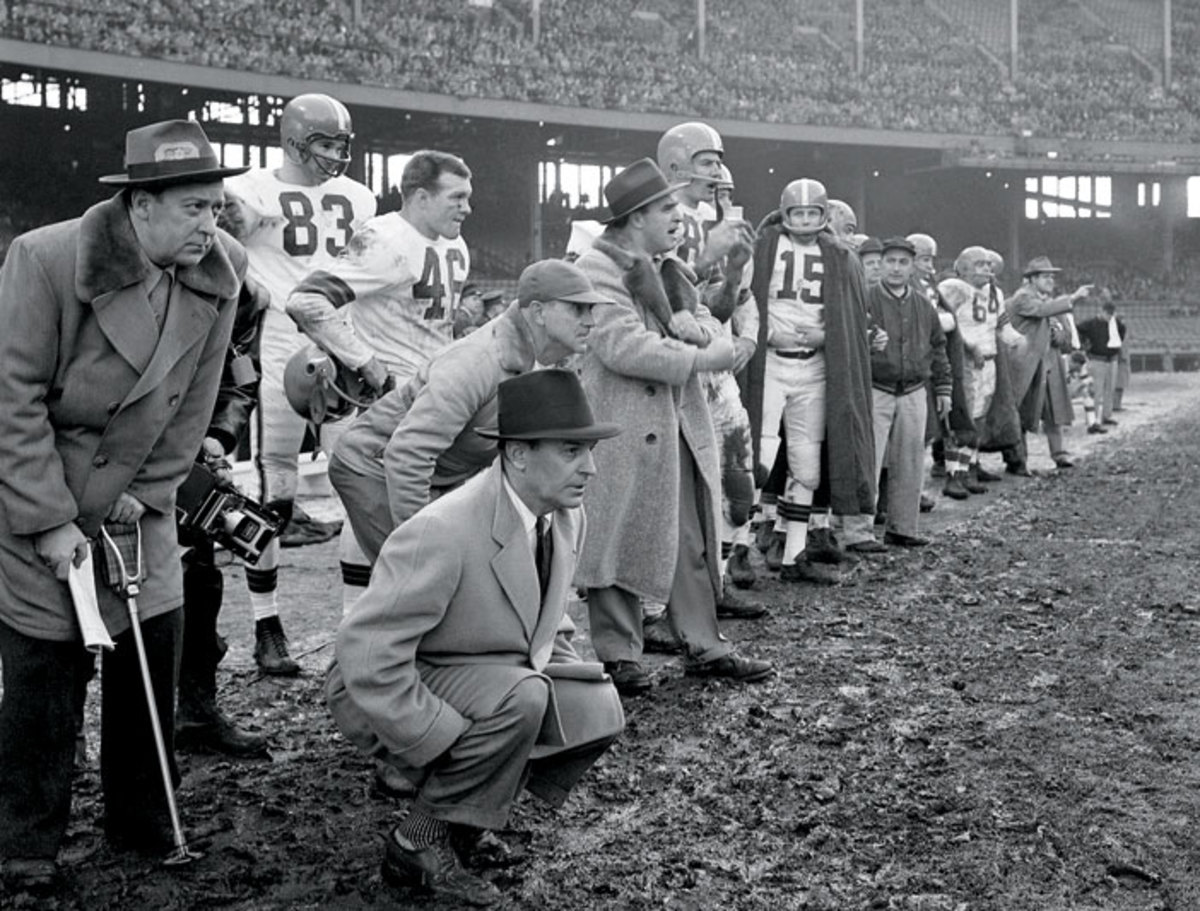
Cleveland assistants were placed up high for a bird’s eye view, communicating what they saw down to the field. (Neil Leifer/Sports Illustrated)
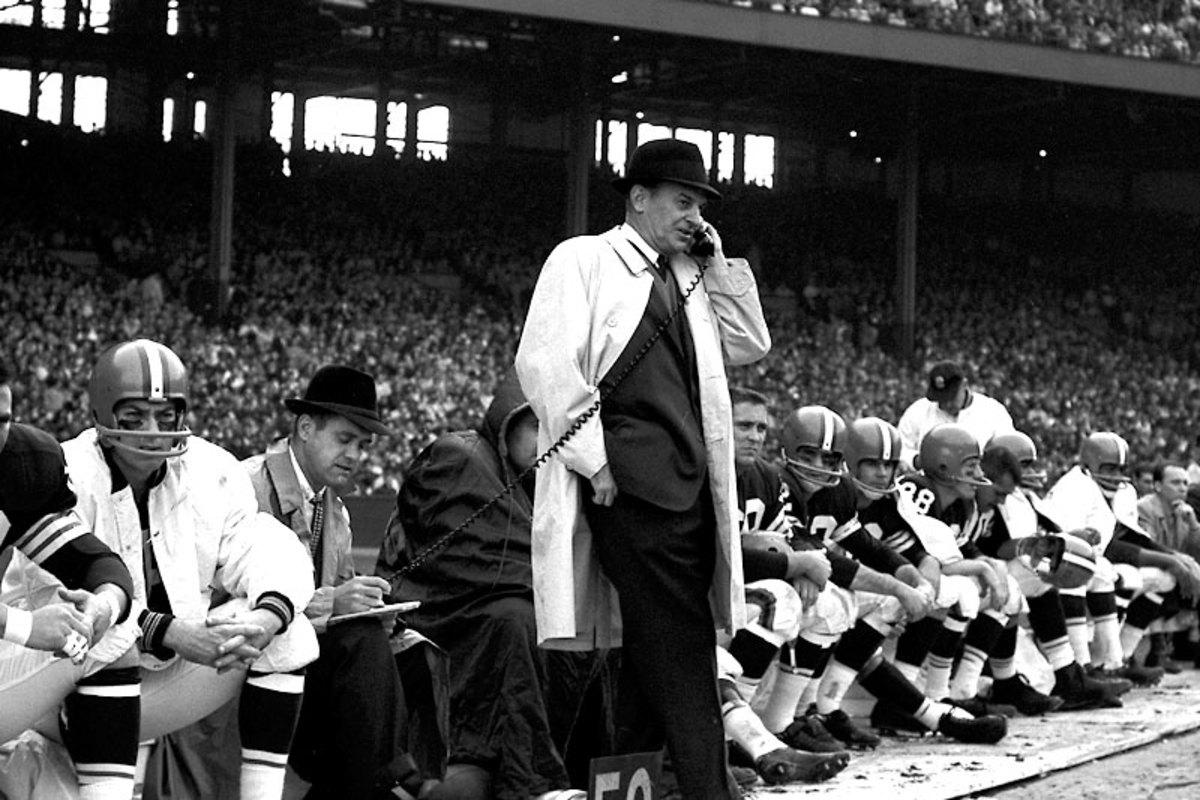
By 1959, Brown was finding it harder to tap unheralded talent and sustain the winning edge. (Neil Leifer/Sports Illustrated)
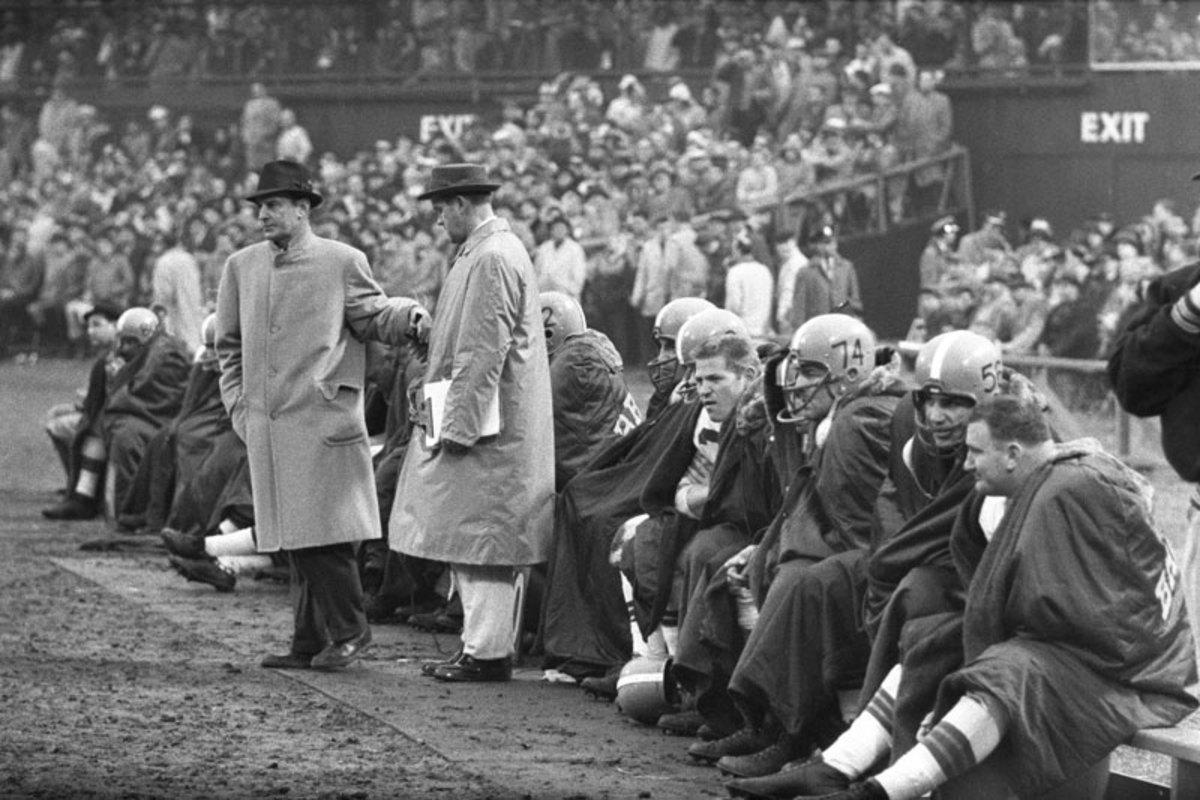
Strict rules concerning players’ behavior began to wear thin as Cleveland’s dynasty faded. (Neil Leifer/Sports Illustrated)
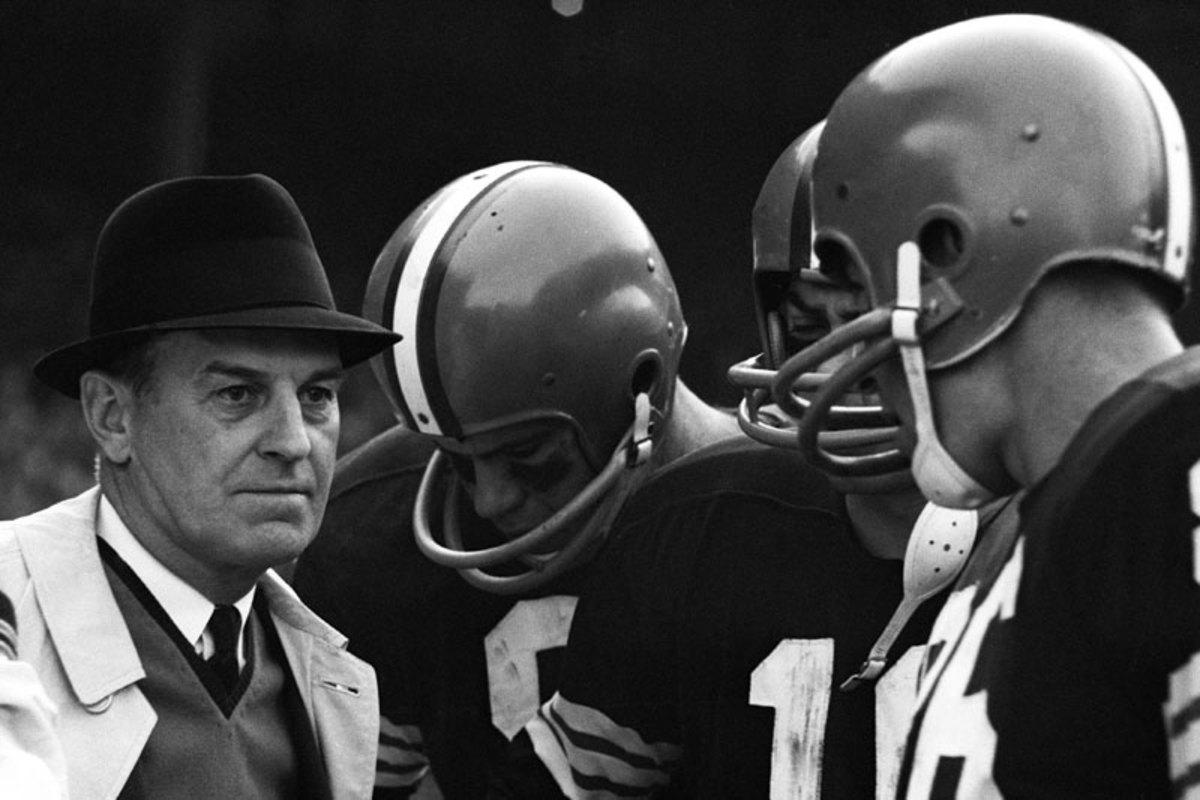
When Art Modell (left) bought the Browns in 1961, it was the beginning of the end of Paul Brown's tenure with the franchise. He was fired less than two years later. (Henry Barr Collection/Diamond Images/Getty Images)
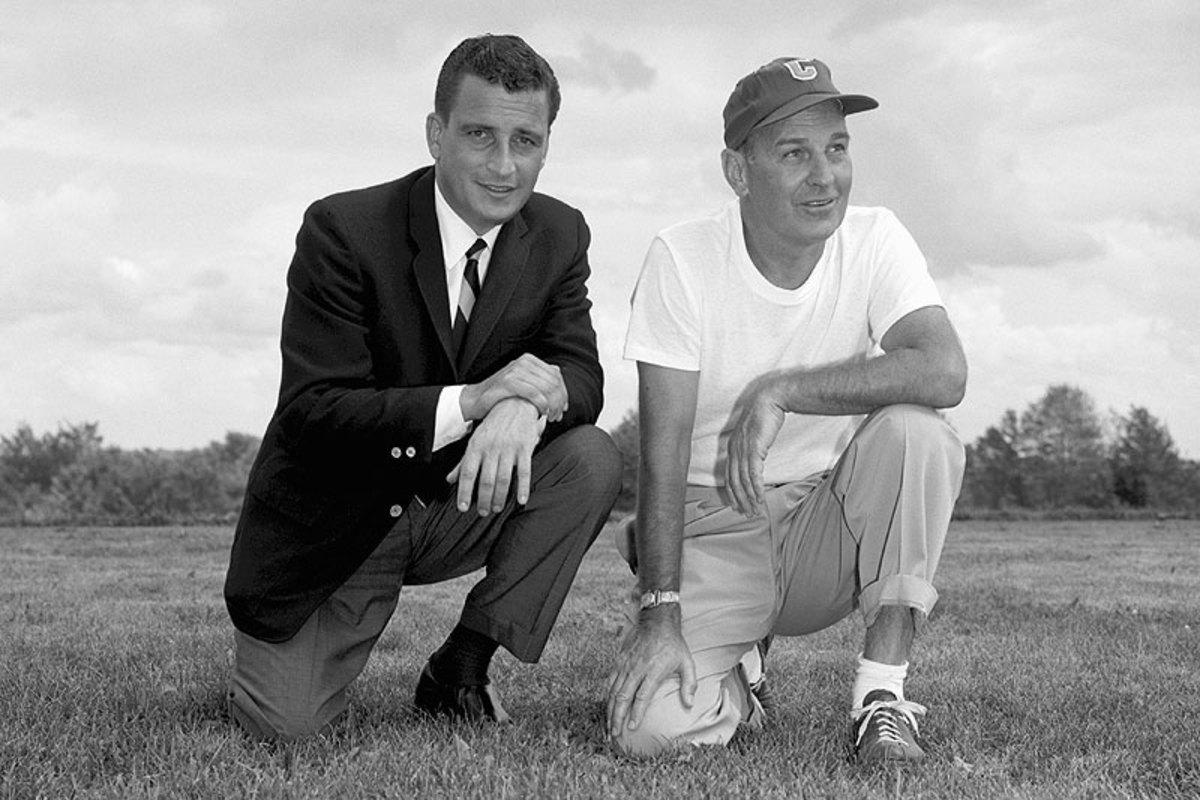
Brown with guard John Wooton on the sideline in ’62 at Kezar Stadium in San Francisco, facing one of the other old AAFC teams, the 49ers. (Neil Leifer/Sports Illustrated)
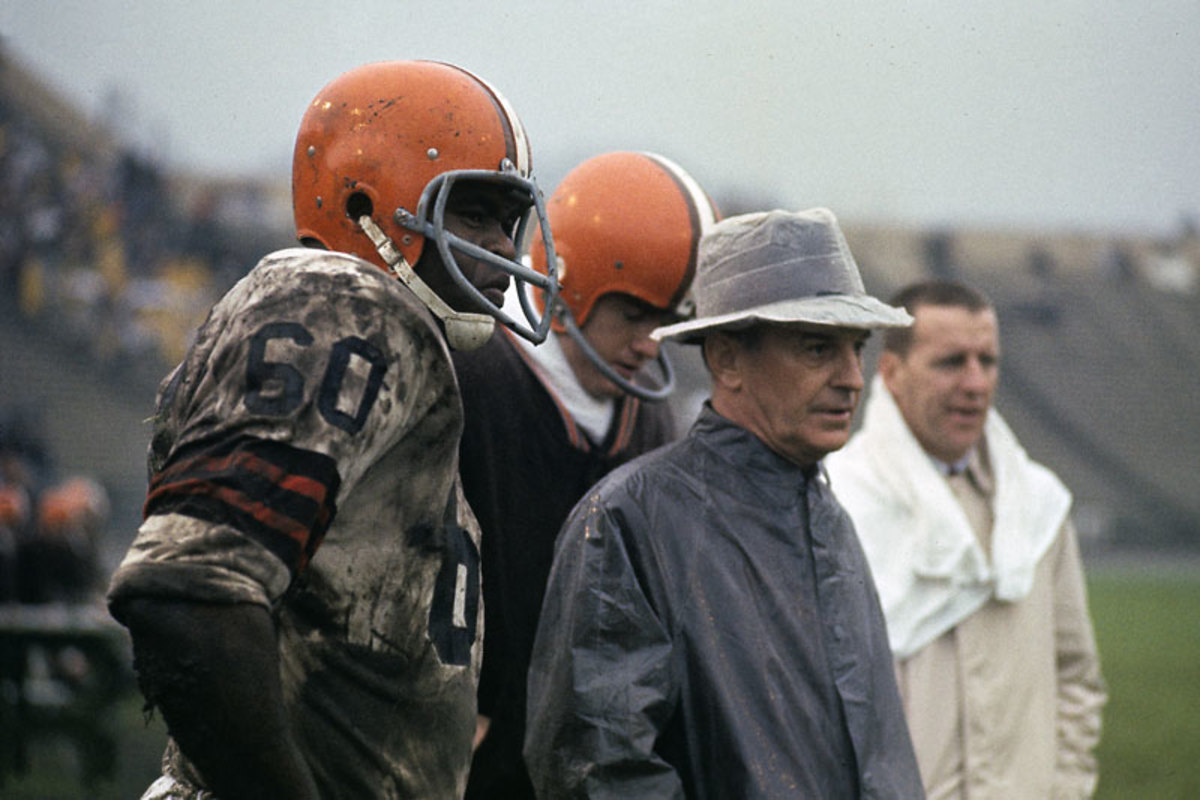
After five years out of the game, Brown founded the Bengals in 1968. (Tony Tomsic/Sports Illustrated)
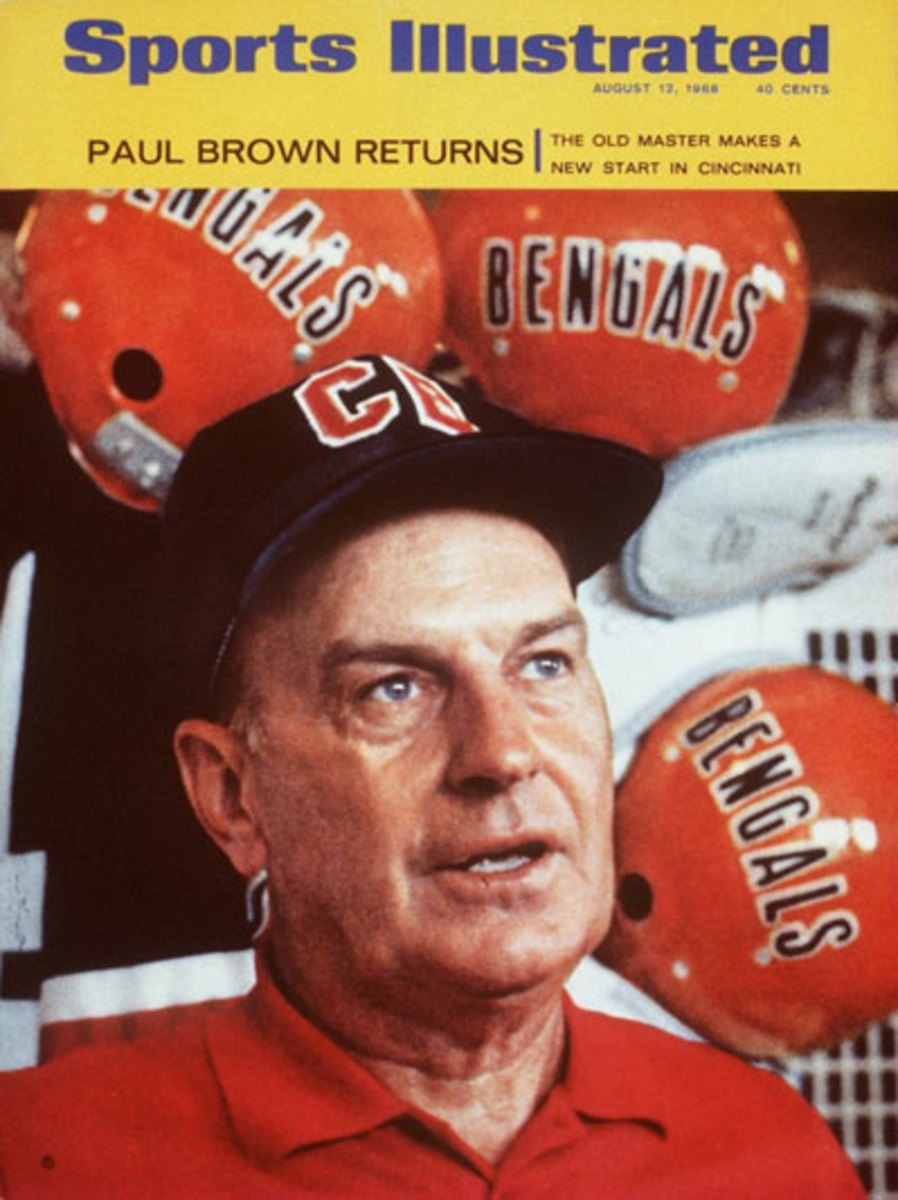
Brown confers with quarterback Sam Wyche—who’d later coach Cincinnati in a Super Bowl—during a game in 1969. (Tony Tomsic/Wireimage.com)
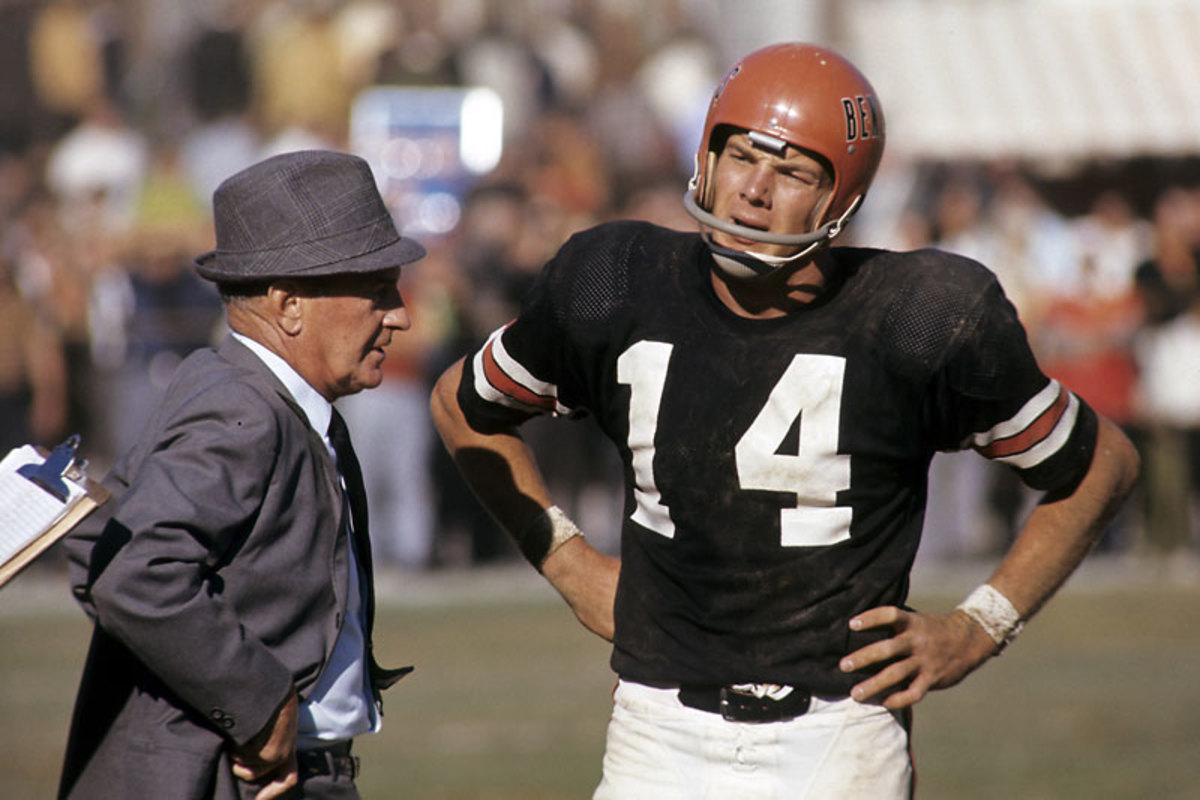
Bill Walsh worked as an assistant under Brown in Cincinnati, where the two refined the offensive concepts that Walsh would employ in San Francisco. He beat the Bengals in two Super Bowls. (Brian Horton/AP)
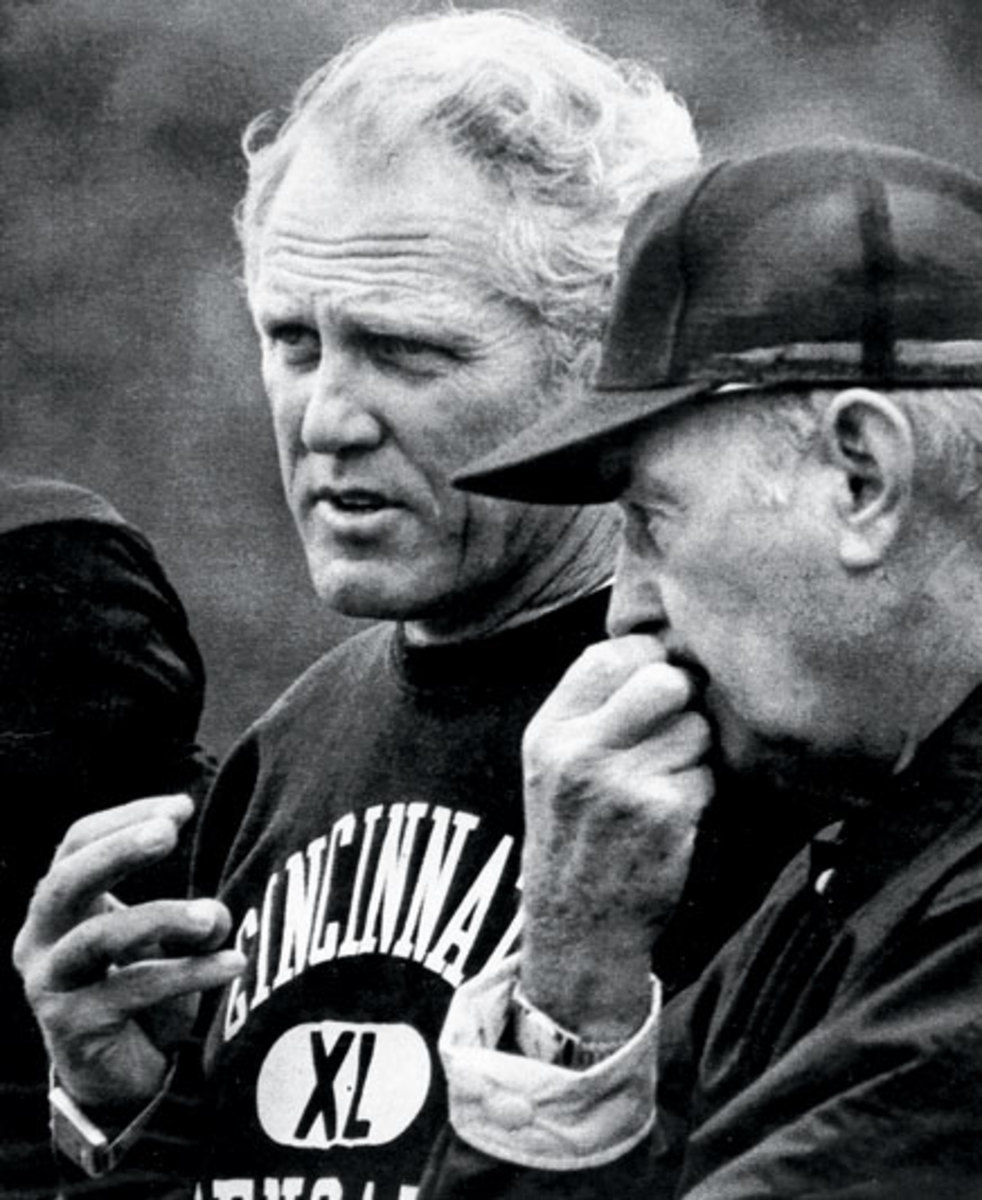
Brown pioneered many of the practices common in today’s NFL, from the draw play to film study, scouting and the taxi squad. (Long Photography Inc./Sports Illustrated)
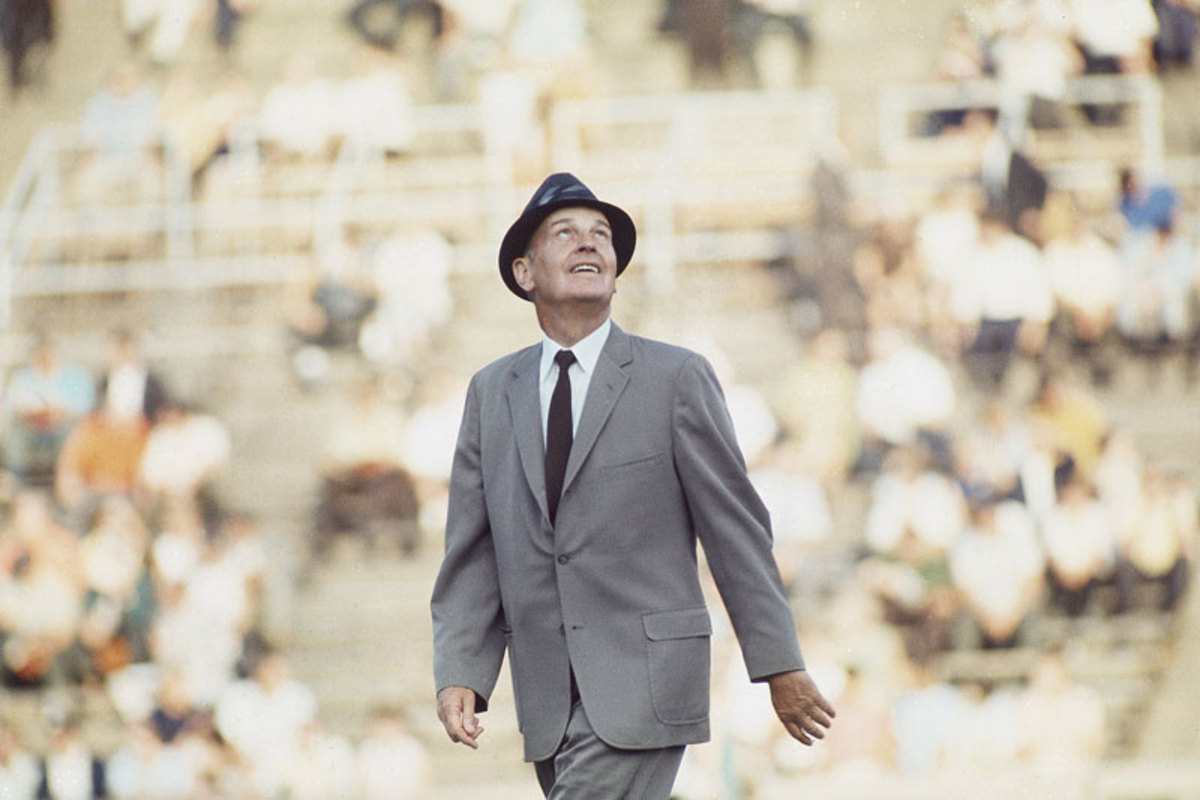
Paul Brown’s annual speech was something to behold. “We don’t want any butchers on this team,” he’d say. “No T-shirts in the dining hall. Don’t eat with your elbows on the table, and eat quietly. We all eat together, every meal, and I want no cliques. I want you to eat at different tables each meal. There is no excuse for missing a meal unless it comes from me. Not an assistant coach or any other official, but from me. I will be at each meal, and I expect you to be.”
Then came the Deuteronomic enumeration of the forbidden vices. “If you’re a drinker or a chaser you’ll weaken the team and we don’t want you. We’re just here for one thing—to win. If I hear you’ve been drinking, I’ll ask you in front of the squad. If you have, you’re through. If you have and deny it, you’ve branded yourself a liar in front of the team.
“You are to watch your dress, your language and the company you keep. When we’re traveling, stay away from that stranger who may want to take you to dinner or talk to you in a hotel lobby. Maybe he isn’t a gambler or after information, but stay away from him anyway.
“The rules for training camp and on the road are simple. In your room at 10 and lights out at 10:30. Sometimes the coaches make a bed check. There is an automatic fine of $500 for any player who sneaks out after bed check. That sticks, too. I have had to levy fines in the past and I have never rescinded one for subsequent good behavior or meritorious performance.”
Brown coached the Bengals for eight seasons; his son still runs the team. (James Drake/SI)

In 1962, Brown related a story to Tex Maule of SI. “A few years ago we had a big end,” the coach said. “I heard he chewed tobacco and spit it on the wall next to his bed. Can you imagine that?
“I went to his room. I told him that I would fine him $500 if he didn’t wash down the walls. Then I stood and watched him wash them. Can you imagine living with an animal like that?”
Brown once turned down champagne at a party someone threw for his birthday because it was in-season. He probably would not have appreciated the Las Vegas exploits of the latest would-be heir to Graham, Johnny Manziel.
In 1961, 35-year-old advertising executive Art Modell bought the team. Unlike past owners, Modell wanted an active role. Brown had always represented the team at league meetings and cast the franchise’s vote in NFL matters, but Modell decreed that he and Brown would attend together. Both parties said all the right things, but it was soon clear that the two could not co-exist. The relationship officially derailed when Brown traded Bobby Mitchell to Washington and Modell found out about it from Marshall, the Redskins’ owner.
Modell waited until both Cleveland newspapers were on strike, and then he fired Brown in January 1963. That ruse didn’t do much to endear Modell to Clevelanders, but the fact remains that following Brown’s firing, player rep Bernie Parrish was quoted as saying, “After contacting most of our veteran players, I found that it was the virtually unanimous opinion that it was time for a change.” Under Blanton Collier, Brown’s top assistant, Cleveland won the championship two years later. The city hasn’t won a thing since.
Brown didn’t return to the sidelines until 1968—the year after he was enshrined in the Pro Football Hall of Fame—when he founded the Cincinnati Bengals. Ever the innovator, he and assistant Bill Walsh tweaked Brown’s old passing attack into an early version of the West Coast offense. (Bill Belichick recently argued that it should really be called the Ohio River Offense.) Brown coached the Bengals for eight years, going 55-56-1, and retired after the 1975 season. He died in 1991, and his son Mike inherited the Cincinnati franchise. Its home, the $455 million Paul Brown Stadium, opened in 2000.
Three years after Paul Brown's death the NFL adopted a rule allowing coaches to communicate with quarterbacks by way of a helmet radio, nearly three decades after Brown first broached the idea. It was a reminder that while his magical run in Cleveland came undone by his failure to keep up with the times, on the field he was always way ahead of them.
Special thanks to the Pro Football Hall of Fame for the helmet photo.

Week 5 Artifacts
Mike Ditka’s Cigar The famous stogie served well to celebrate Super Bowl XX, and with the mustache and aviators made for a look that became legend in a series of SNL skits that elevated Da Coach to godhood. read more → |
|---|
Kurt Warner’s Hy-Vee An unassuming supermarket in Iowa would hardly seem the place to find a future two-time league MVP and Super Bowl champ. read more → |
The Gatorade Bucket Drenching the coach in energy drink became an NFL celebratory tradition in the mid-’80s—and, surprisingly, nothing has really replaced it. read more → |
Tom Landry’s Fedora The coach’s unassuming hat became a symbol of plainspoken Cowboys excellence during a reign that included 20 years straight winning seasons. read more → |
Pete Rozelle’s Typewriter The future commissioner tapped out high school sports reports on the same machine that became a transformative communication tool when he took over the NFL. read more → |
Johnny Unitas’ High-Tops Styles changed, and so did the playing surfaces, but Johnny U didn’t yield on his choice of old-school footwear. With an arm like that, what did it matter what he had on his feet? read more → |
1920 Akron Pros Fob The first NFL champions—the title was decided by committee, not on the field—got little gold trinkets rather than blinged out rings. read more → |
Brett Favre’s Deactivation Report A simple sheet of paper brought to an end one of the game’s most remarkable ironman streaks—Favre’s record 297 straight starts at quarterback. read more → |

